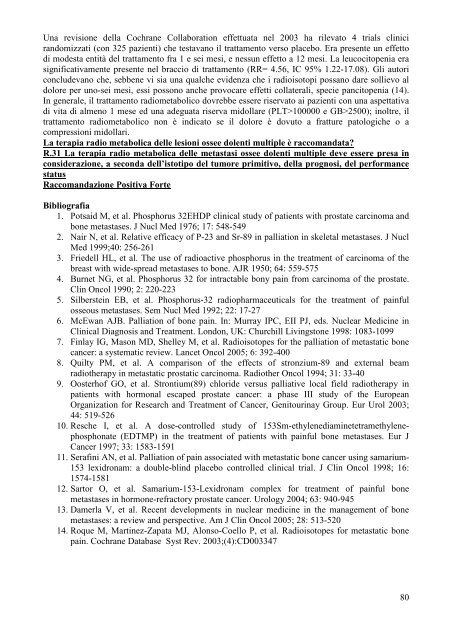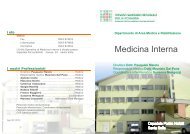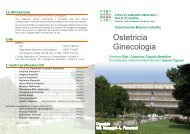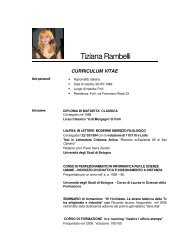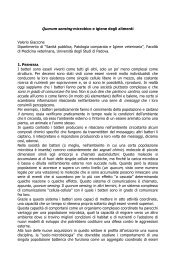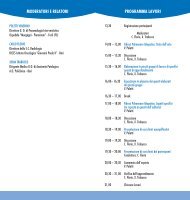linea guida aiom - terapia del dolore in oncologia - Azienda USL di ...
linea guida aiom - terapia del dolore in oncologia - Azienda USL di ...
linea guida aiom - terapia del dolore in oncologia - Azienda USL di ...
You also want an ePaper? Increase the reach of your titles
YUMPU automatically turns print PDFs into web optimized ePapers that Google loves.
Una revisione <strong>del</strong>la Cochrane Collaboration effettuata nel 2003 ha rilevato 4 trials cl<strong>in</strong>ici<br />
randomizzati (con 325 pazienti) che testavano il trattamento verso placebo. Era presente un effetto<br />
<strong>di</strong> modesta entità <strong>del</strong> trattamento fra 1 e sei mesi, e nessun effetto a 12 mesi. La leucocitopenia era<br />
significativamente presente nel braccio <strong>di</strong> trattamento (RR= 4.56, IC 95% 1.22-17.08). Gli autori<br />
concludevano che, sebbene vi sia una qualche evidenza che i ra<strong>di</strong>oisotopi possano dare sollievo al<br />
<strong>dolore</strong> per uno-sei mesi, essi possono anche provocare effetti collaterali, specie pancitopenia (14).<br />
In generale, il trattamento ra<strong>di</strong>ometabolico dovrebbe essere riservato ai pazienti con una aspettativa<br />
<strong>di</strong> vita <strong>di</strong> almeno 1 mese ed una adeguata riserva midollare (PLT>100000 e GB>2500); <strong>in</strong>oltre, il<br />
trattamento ra<strong>di</strong>ometabolico non è <strong>in</strong><strong>di</strong>cato se il <strong>dolore</strong> è dovuto a fratture patologiche o a<br />
compressioni midollari.<br />
La <strong>terapia</strong> ra<strong>di</strong>o metabolica <strong>del</strong>le lesioni ossee dolenti multiple è raccomandata?<br />
R.31 La <strong>terapia</strong> ra<strong>di</strong>o metabolica <strong>del</strong>le metastasi ossee dolenti multiple deve essere presa <strong>in</strong><br />
considerazione, a seconda <strong>del</strong>l’istotipo <strong>del</strong> tumore primitivo, <strong>del</strong>la prognosi, <strong>del</strong> performance<br />
status<br />
Raccomandazione Positiva Forte<br />
Bibliografia<br />
1. Potsaid M, et al. Phosphorus 32EHDP cl<strong>in</strong>ical study of patients with prostate carc<strong>in</strong>oma and<br />
bone metastases. J Nucl Med 1976; 17: 548-549<br />
2. Nair N, et al. Relative efficacy of P-23 and Sr-89 <strong>in</strong> palliation <strong>in</strong> skeletal metastases. J Nucl<br />
Med 1999;40: 256-261<br />
3. Frie<strong>del</strong>l HL, et al. The use of ra<strong>di</strong>oactive phosphorus <strong>in</strong> the treatment of carc<strong>in</strong>oma of the<br />
breast with wide-spread metastases to bone. AJR 1950; 64: 559-575<br />
4. Burnet NG, et al. Phosphorus 32 for <strong>in</strong>tractable bony pa<strong>in</strong> from carc<strong>in</strong>oma of the prostate.<br />
Cl<strong>in</strong> Oncol 1990; 2: 220-223<br />
5. Silberste<strong>in</strong> EB, et al. Phosphorus-32 ra<strong>di</strong>opharmaceuticals for the treatment of pa<strong>in</strong>ful<br />
osseous metastases. Sem Nucl Med 1992; 22: 17-27<br />
6. McEwan AJB. Palliation of bone pa<strong>in</strong>. In: Murray IPC, EII PJ, eds. Nuclear Me<strong>di</strong>c<strong>in</strong>e <strong>in</strong><br />
Cl<strong>in</strong>ical Diagnosis and Treatment. London, UK: Churchill Liv<strong>in</strong>gstone 1998: 1083-1099<br />
7. F<strong>in</strong>lay IG, Mason MD, Shelley M, et al. Ra<strong>di</strong>oisotopes for the palliation of metastatic bone<br />
cancer: a systematic review. Lancet Oncol 2005; 6: 392-400<br />
8. Quilty PM, et al. A comparison of the effects of stronzium-89 and external beam<br />
ra<strong>di</strong>otherapy <strong>in</strong> metastatic prostatic carc<strong>in</strong>oma. Ra<strong>di</strong>other Oncol 1994; 31: 33-40<br />
9. Oosterhof GO, et al. Strontium(89) chloride versus palliative local field ra<strong>di</strong>otherapy <strong>in</strong><br />
patients with hormonal escaped prostate cancer: a phase III study of the European<br />
Organization for Research and Treatment of Cancer, Genitour<strong>in</strong>ay Group. Eur Urol 2003;<br />
44: 519-526<br />
10. Resche I, et al. A dose-controlled study of 153Sm-ethylene<strong>di</strong>am<strong>in</strong>etetramethylenephosphonate<br />
(EDTMP) <strong>in</strong> the treatment of patients with pa<strong>in</strong>ful bone metastases. Eur J<br />
Cancer 1997; 33: 1583-1591<br />
11. Seraf<strong>in</strong>i AN, et al. Palliation of pa<strong>in</strong> associated with metastatic bone cancer us<strong>in</strong>g samarium-<br />
153 lexidronam: a double-bl<strong>in</strong>d placebo controlled cl<strong>in</strong>ical trial. J Cl<strong>in</strong> Oncol 1998; 16:<br />
1574-1581<br />
12. Sartor O, et al. Samarium-153-Lexidronam complex for treatment of pa<strong>in</strong>ful bone<br />
metastases <strong>in</strong> hormone-refractory prostate cancer. Urology 2004; 63: 940-945<br />
13. Damerla V, et al. Recent developments <strong>in</strong> nuclear me<strong>di</strong>c<strong>in</strong>e <strong>in</strong> the management of bone<br />
metastases: a review and perspective. Am J Cl<strong>in</strong> Oncol 2005; 28: 513-520<br />
14. Roque M, Mart<strong>in</strong>ez-Zapata MJ, Alonso-Coello P, et al. Ra<strong>di</strong>oisotopes for metastatic bone<br />
pa<strong>in</strong>. Cochrane Database Syst Rev. 2003;(4):CD003347<br />
80


